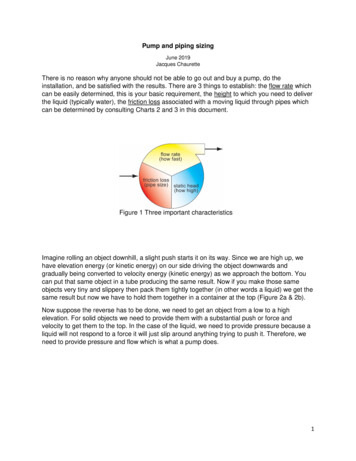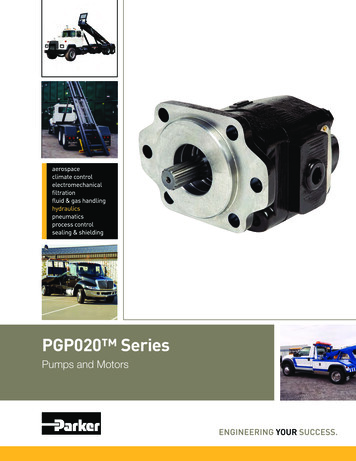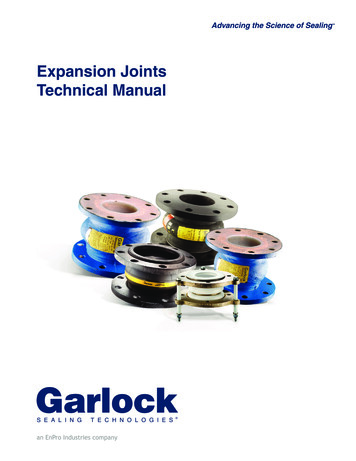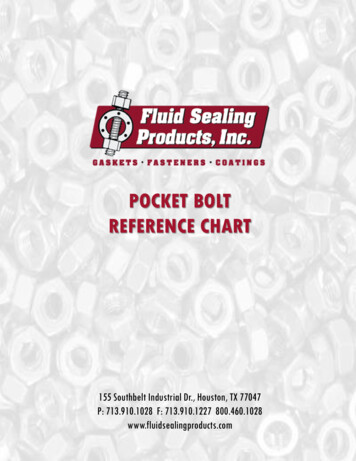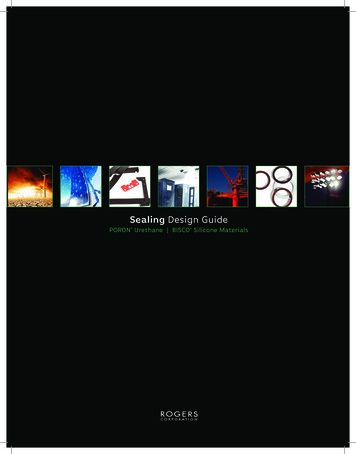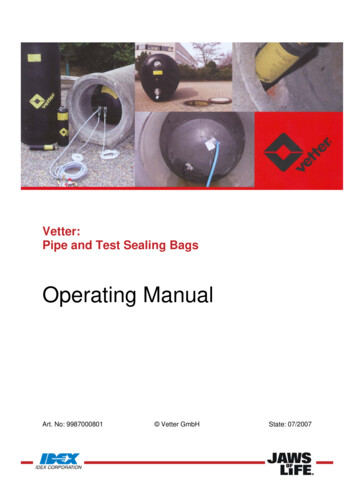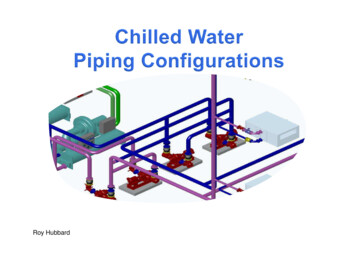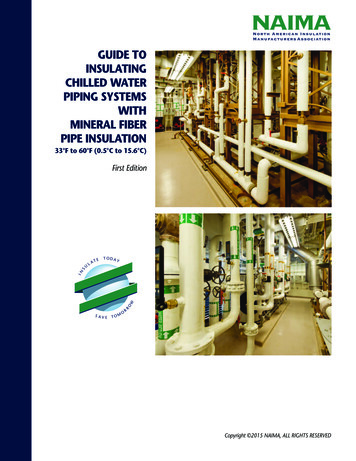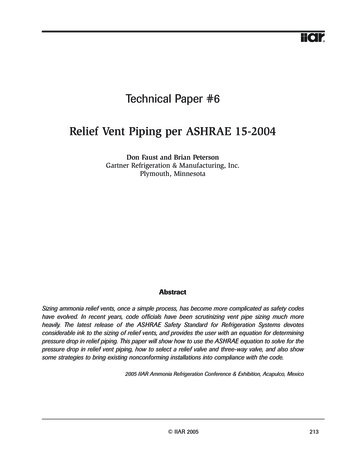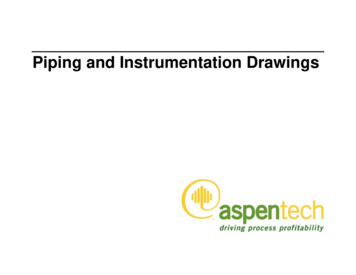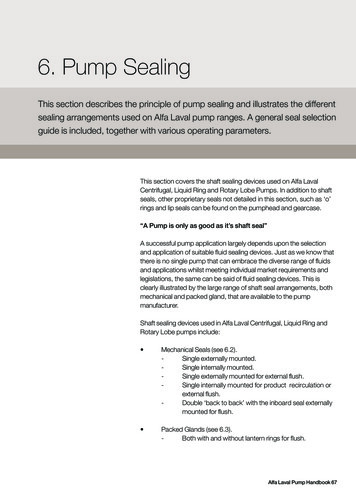
Transcription
Pump sealing6. Pump SealingThis section describes the principle of pump sealing and illustrates the differentsealing arrangements used on Alfa Laval pump ranges. A general seal selectionguide is included, together with various operating parameters.This section covers the shaft sealing devices used on Alfa LavalCentrifugal, Liquid Ring and Rotary Lobe Pumps. In addition to shaftseals, other proprietary seals not detailed in this section, such as ‘o’rings and lip seals can be found on the pumphead and gearcase.“A Pump is only as good as it’s shaft seal”A successful pump application largely depends upon the selectionand application of suitable fluid sealing devices. Just as we know thatthere is no single pump that can embrace the diverse range of fluidsand applications whilst meeting individual market requirements andlegislations, the same can be said of fluid sealing devices. This isclearly illustrated by the large range of shaft seal arrangements, bothmechanical and packed gland, that are available to the pumpmanufacturer.Shaft sealing devices used in Alfa Laval Centrifugal, Liquid Ring andRotary Lobe pumps include: Mechanical Seals (see 6.2).Single externally mounted.Single internally mounted.Single externally mounted for external flush.Single internally mounted for product recirculation orexternal flush.Double ‘back to back’ with the inboard seal externallymounted for flush. Packed Glands (see 6.3).Both with and without lantern rings for flush.Alfa Laval Pump Handbook 67
Pump sealingCentrifugal and Liquid Ring pumps only have one shaft seal whereasRotary Lobe pumps employ a minimum of two shaft seals (one pershaft). Generally all shaft seals are under pressure with the pressuregradient across the seal being from pumped fluid to atmosphere. Theexceptions will be single internally mounted or double seals where theproduct recirculation (single internally mounted only) or flush pressureis greater than the pump pressure, resulting in the pressure gradientbeing reversed.Mechanical seals meet the majority of application demands and ofthese, single and single flushed seals are most frequently specified.The application of double mechanical seals is increasing to meet bothprocess demands for higher sanitary standards and legislationrequirements, particularly those related to emissions.The majority of proprietary mechanical seals available from sealmanufacturers have been designed for single shaft pump concepts,such as Centrifugal and Liquid Ring pumps. These pump types do notimpose any radial or axial constraints on seal design. However onRotary Lobe type pumps the need to minimise the shaft extensionbeyond the front bearing places significant axial constraints. If thiswere extended, the shaft diameter would increase introducing a radialconstraint - because shafts on a rotary lobe pump are in the sameplane, the maximum diameter of the seal must be less than the shaftcentres. Most designs therefore can only accommodate ‘bespoke’ or‘customised’ seal design. This is not done to take any commercialadvantage but it is as a consequence of the rotary lobe pump designconcept.68 Alfa Laval Pump Handbook
Pump sealingThere is often more than onesolution and sometimes noideal solution, therefore acompromise may have to beconsidered.Selection of shaft seals is influenced by many variables: Shaft diameter and speed Fluid to be pumpedTemperatureSolids-Thermal stabilityAir reacting-effect on materials?can interface film be maintained?drag on seal faces?clogging of seal restricting movement?can interface film be established andmaintained?stiction at seal faces?does product shear, thin, thicken or‘work’ - balling/carbonise?can interface film be established andmaintained?size?abrasiveness?density?clogging of seal restricting movement?can interface film be established andmaintained?what, if any change?what, if any change? Pressure-within seal limits?fluctuations?peaks/spikes?cavitation? Services-flush?pressure?temperature?continuity? Health and t?carcinogenic?ViscosityFluid behaviour-Alfa Laval Pump Handbook 69
Pump sealing6.1 Mechanical Seals - GeneralMechanical seals are designed for minimal leakage and represent themajority of Centrifugal, Liquid Ring and Rotary Lobe pump sealingarrangements.Mechanical seal selection must consider: The materials of seal construction, particularly the sealingfaces and elastomers.The mounting attitude to provide the most favourableenvironment for the seal.The geometry within which it is to be mounted.A mechanical seal typically comprises of: A primary seal, comprising of stationary and rotary seal rings.Two secondary seals, one for each of the stationary androtary seal rings.A method of preventing the stationary seal ring from rotating.A method of keeping the stationary and rotary seal ringstogether when they are not hydraulically loaded i.e. whenpump is stopped.A method of fixing and maintaining the working length.The Primary SealComprises of two flat faces, one rotating and one stationary, whichsupport a fluid film, thus minimising heat generation and subsequentmechanical damage.Commonly used material combinations are:CarbonCarbonCarbonSilicon CarbideTungsten Carbide70 Alfa Laval Pump Handbook-Stainless SteelSilicon CarbideTungsten CarbideSilicon CarbideTungsten Carbide
Pump sealingThe Secondary SealThis is required to provide a seal between the primary seal rings andthe components with which they interface. Also it can provide acushion mounting for the seat ring to reduce any effects of mechanicalstress i.e. shock loads.Types of secondary seal are: ‘O’ rings Cups Gaskets WedgesFor Alfa Laval pump ranges the ‘O’ ring is the most commonly type ofsecondary seal used. It’s simple and versatile concept is enhancedwith the following comprehensive material options: NBR EPDM FPM PTFE MVQ FEP Kalrez Chemraz These are fully described in section 5.3.Mechanical Seal Face/’O’ Ring Material �üMVQüüüüüPTFEüüüüüFPMüüTungsten CarbideüüEPDMüüüSeal ‘O’RingNBRüüüSilicon CarbideSRUSX (see note)üüüüüüüüüüüüüüStainless SteelRotary LobeüüCarbonLKHLKH-MultistageLKHP-High PressureLKHSPLKHILKH-Ultra PureMRStationarySeal FaceTungsten CarbideCentrifugal/Liquid ringSilicon CarbidePump RangeCarbonPump TypeStainless SteelRotarySeal FaceüüüüüüüNote: SX1 pump has tungsten carbide seal faces, not silicon carbide seal faces.Table 6.1aStationary Seal Ring Anti-RotationIdeally the selected device listed below will also allow for axialresilience. Flats Pins Elastomer resilience Press fit ClampsRotary Seal Ring DriveIdeally the selected device listed below will allow for a degree of axialmovement. Spring Bellows Physical positioning Elastomer resilienceAlfa Laval Pump Handbook 71
Pump sealingOne of the main causes ofseal failure is for the sealworking length not beingcorrectly maintained.Working LengthThe ideal design should eliminate/minimise possibilities for error byincorporating: Physical position i.e. step on shaft Grub screwsFig. 6.1a Typical single mechanical sealused in rotary lobe pumps7Item1234567DescriptionStationary seal ring O-ringStationary seal ringRotary seal ringRotary seal ring O-ringWave springDrive ringGrub screwWorking lengthFig. 6.1b Typical single mechanical sealused in centrifugal pumps3Pump shaftInterface filmAprox. 1 mmFig. 6.1c Principle of mechanical sealoperation72 Alfa Laval Pump HandbookImpeller2Drive ring451Item12345DescriptionStationary seal ringRotary seal ringSpringStationary seal ringO-ringRotary seal ring O-ringPrinciple of Mechanical Seal OperationThe function of the assembly is a combination of the extreme primaryseal face flatness and applied spring force. Once the pump isoperational, hydraulic fluid forces combine with seal design featuresi.e. balance, which push the seal faces together. This reduces the fluidinterface thickness to a minimum whilst increasing pressure drop,therefore minimising pumped fluid leakage.
Pump sealingFig. 6.1d Principle of mechanical sealoperationSpring forceFluidpressureStationaryseal ringRotating seal ringThe gap between the seal ring surfaces is enlarged to clarify theprinciple of mechanical sealing.Mechanical Seal MountingMost mechanical seals can be mounted externally or internally.External Mechanical SealsThe majority of mechanical seals used on Alfa Laval pump ranges aremounted externally, meaning that all the rotating parts of themechanical seal (i.e. part of the rotary seal ring, spring, drive ring etc)are not in contact with the fluid to be pumped. The externallymounted mechanical seal is considered easy to clean, as only theinside of the stationary and rotary seal rings and there associated ‘o’rings are in contact with the fluid being pumped. The R00 typemechanical seals used on the SX rotary lobe pump range, describedin 6.2, are an exception to this, as it is the outside and not the insideof the seal components that is in contact with the fluid being pumped.Externally mounted seals have a lower pressure rating than theequivalent seal mounted internally.Fig. 6.1e Typical external shaft sealRotating partsFluidAlfa Laval Pump Handbook 73
Pump sealingInternal Mechanical SealsSome mechanical seals are mounted internally, meaning that most ofthe rotating parts are in contact with the fluid being pumped. Theinternal mechanical seal is designed with sufficient clearance aroundthe rotating parts so that it can be cleaned as efficiently as possibleand can withstand relatively high fluid pressures.Fig. 6.1f Typical internal shaft sealRotating partsFluidFor the Alfa Laval pump ranges, both the externally and internallymounted types of mechanical seal are available as single and singleflushed versions. The externally mounted mechanical seal onAlfa Laval pump ranges is also available as a double flushedmechanical seal for some pump models. The typical single, singleflushed and double flushed mechanical seal arrangements aredescribed as follows:Single Mechanical SealThis is the simplest shaft seal version, which has already beendescribed previously in this section. This seal arrangement is generallyused for fluids that do not solidify or crystallise in contact with theatmosphere and other non-hazardous duties. For satisfactoryoperation it is imperative the seal is not subjected to pressuresexceeding the maximum rated pressure of the pump. Also the pumpmust not be allowed to run ‘dry’, thus avoiding damage to the sealfaces, which may cause excessive seal leakage.Typical applications are listed below, but full product/fluid andperformance data must be referred to the seal supplier for verification. Alcohol Animal Fat Aviation Fuel Beer Dairy Creams Fish Oil Fruit Juice Liquid Egg Milk Shampoo Solvents Vegetable Oil Water Yoghurt74 Alfa Laval Pump Handbook
Pump sealingSingle Flushed Mechanical SealThe definition of ‘flush’ is to provide a liquid barrier or support to theselected seal arrangement. This seal arrangement is generally usedfor any of the following conditions: where the fluid being pumped can coagulate, solidify orcrystallise when in contact with the atmosphere. when cooling of the seals is necessary dependent upon thefluid pumping temperature.This seal arrangement used on externally mounted seals requires thesupply of liquid to the atmospheric side of the mechanical seal to flushthe seal area. The characteristics of the fluid being pumped and theduty conditions will normally determine if a flush is necessary. Whenselecting a flushing liquid you must ensure that it is chemicallycompatible with the relevant materials of pump/seal construction andfully compatible with the fluid being pumped. Consideration should begiven to any temperature limitations that may apply to the flushingliquid to ensure that hazards are not created (i.e. explosion, fire, etc).The flushing liquid is allowed to enter the seal housing at low pressurei.e. 0.5 bar max (7 psi max) to act as a barrier.This most basic flush system, sometimes referred to as quench,provides liquid to the atmosphere side of the mechanical seal therebyflushing away any product leakage. For the majority of pump modelsthe flushed seal comprises of the same stationary and rotating partsas the single seal, with the addition of a seal housing having a flushingconnection and/or flushing tubes and a lip seal.Fig. 6.1g Typical externally mountedsingle flushed mechanical seal used inrotary lobe pumps12Item123456789101112DescriptionStationary seal ring O-ringStationary seal ringRotary seal ringRotary seal ring O-ringWave springDrive ringSpacer O-ringSpacerGasketSeal housingLip sealGrub screwAlfa Laval Pump Handbook 75
Pump sealingFig. 6.1h Typical externally mountedsingle flushed mechanical seal used incentrifugal pumpsItem123DescriptionSeal housingLip sealFlushing tubesTypical applications are listed below, but full product/fluid andperformance data must be referred to the seal supplier for verification. Adhesive Caramel Detergent Fruit Juice Concentrate Gelatine Jam Latex Paint Sugar Syrup Toothpaste YeastDouble Flushed Mechanical SealThis seal arrangement is generally used with hostile media conditionsi.e. high viscosity, fluid is hazardous or toxic. The double flushed sealused on Alfa Laval pump ranges is basically two single mechanicalseals mounted ‘back to back’. This seal generally comprises of thesame stationary and rotating parts as the single seal for the majorityof pump models, with the addition of a seal housing having a flushingconnection and/or flushing tubes (dependent upon pump type). Acompatible flushing liquid is pressurised into the seal housing at apressure of 1 bar (14 psi) minimum above the discharge pressure ofthe pump. This results in the interface film being the flushing liquid andnot the pumped liquid. Special attention is required in selecting sealfaces and elastomers.The arrangement in contact with the pumped
Pump sealing Single Flushed Mechanical Seal The definition of ‘flush’ is to provide a liquid barrier or support to the selected seal arrangement. This seal arrangement is generally used for any of the following conditions: where the fluid being pumped can coagulate, File Size: 466KBPage Count: 17
